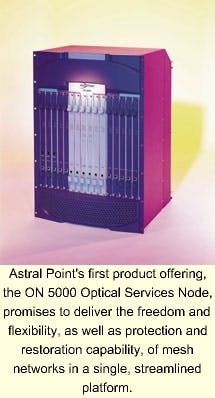Astral Point's ON 5000 enables carriers to overcome metro space barriers
By ROBERT PEASE
Astral Point Communications Inc., a telecommunications startup based in Chelmsford, MA, is challenging for the metropolitan multiservice network space with its first product launch, the ON 5000 Optical Services Node. Based on the company's patent-pending "self-healing mesh" algorithm, the ON 5000 is designed to help carriers overcome the barriers to fast, easy provisioning in the metropolitan area by enabling Synchronous Optical Network (SONET)-quality protection and restoration capability in ring or mesh networks.
The ON 5000 combines the functionality of SONET/ Syn chronous Digital Hierarchy add/ drop multiplexing (ADM), optical ADM, digital crossconnect systems (DCS), local-area network ex ten sion, and Asyn chron ous Trans fer Mode (ATM) swit ch ing in a single system. By doing so, carriers can offer leased-line, ATM, and Ethernet services aggregated into a flexible mesh topology with SONET-quality protection and restoration.
Astral Point's product consists of three major elements. A switch fabric provides electronic services such as leased lines, ATM, and distributed DCS. Transponders map high-speed services directly over wavelengths. Finally, a passive optical ADM maps each wavelength coming from the switch fabric. This combination promises carriers a wide range of services that can be launched from a single network element.
The ON 5000 can be deployed in an existing SONET ring infrastructure to provide a foundation for building optical mesh networks that begin as tactical bandwidth additions on a single fiber span. By using dense wavelength-division multiplexing (DWDM), the ON 5000 increases bandwidth capacity on an incremental span-by-span basis as needed to provide immediate fiber-span relief.
By eliminating the need for full DWDM build-out at network inception, the ON 5000 enables carriers to adopt a "pay-as-you-grow" model for DWDM deployment. Astral Point contends that the product maximizes DWDM efficiency by directly mapping service bandwidth to wavelengths.
Astral Point's self-healing mesh technology provides sub-50-msec protection and restoration that can scale to hundreds of nodes, emulating a key attribute of SONET in a more flexible network environment. Carriers can further maximize fiber efficiency by offering "protection classes" of service. When a primary path is established, a protection path is also established.
"Carriers are able to choose their level of protection," says Bill Mitchell, vice president of marketing at Astral Point. "They can designate the protection path to be 100% guaranteed, choose a lower quality-of-service class or smaller bandwidth allocation, or opt for no protection at all. Unprotected services use the idle protection bandwidth of another user, thereby creating a new revenue opportunity for an under-utilized fixed asset. This unprotected service is preempted in the event of a fiber failure. Protection paths can also use different media than the primary paths."
At press time, Astral Point's first-announced customer, Advanced TeleCom Group Inc. (Santa Rosa, CA), is beta testing the ON 5000 within its networks. A major purchase agreement of up to $25 million is planned, contingent upon successful completion of the tests. With numerous other vendors entering the same metropolitan space, Astral Point hopes to gain ground in establishing a leadership position. According to Chris Nicoll, an analyst with Current Analysis in Sterling, VA, the company's success will hinge on how well it meets this goal.
"Astral Point must separate its message from that of the numerous vendors in this space, and getting above all the noise is a major challenge for any new company," says Nicoll. "Startups also need to show how their new products im pact the market through additional customer wins that demonstrate different applications. Large vendors will also be moving into the metro space, making it difficult for Astral Point and others to extend product lines and compete with the likes of Lucent, Nortel, and others."
Some benefits of the ON 5000 are impressive, according to Nicoll's analysis, starting with the product's ability to integrate functionality into a single DWDM multiplexer to provide a cost-effective solution. The ON 5000 also supports both copper and optical services, making it attractive for use in both legacy and new infrastructures. Being able to use copper-based services for backup helps address service-provider network-reliability issues.
"In areas where fiber is very expensive or in short supply, the ON 5000 can use 45-Mbit/sec T3 links for backup," says Nicoll. "Although capacity is lost, connectivity for high-priority traffic can be retained."A unique capability of the ON 5000 is the high density of copper interfaces available on the system. The product supports up to 400 DS-1, 120 DS-3, 64 OC-3c, 16 OC-12c, and four OC-48c ports as well as four DWDM transponders. The OC interfaces are all 1:1 spared, and two chassis-along with an optical-access shelf-can fit into a single 7-ft bay, effectively doubling the port densities for a footprint.
Also, says Nicoll, management features make service provisioning less burdensome on the operations staff. Astral Point offers point-and-click end-to-end provisioning of circuits and auto-discovery of new nodes added to the network and boasts a provisioning time of one-10th that of standard SONET provisioning. The management system is telecommunications-management network compliant, enabling easy integration with existing operational support-system operating systems.
Astral Point's ON 5000 will begin general-availability shipping this month. The product is priced from $30,000 to $250,000, depending on the configuration.

